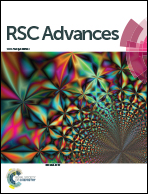Luminescence and energy transfer of a color tunable phosphor: Tb3+ and Eu3+ co-doped ScPO4
Abstract
A series of novel emission-tunable ScPO4:xTb3+, yEu3+ phosphors were prepared by a high temperature solid-state reaction. The phase purity was examined using X-ray diffraction refinement. X-ray photoelectron spectroscopy (XPS) and the crystal information, luminescence properties and energy transfer between Tb3+ and Eu3+ are analyzed systematically. The cross relaxation from 5D3 to 5D4 of single doped Tb3+ in the host is investigated. The energy transfer between Tb3+ and Eu3+ has been demonstrated by the decay times, which are ascribed to the dipole–dipole (d–d) mechanism, and the ηT reaches 54.4%. Additionally, the energy transfer critical distance between Tb3+ and Eu3+ was calculated to be about 12.95 Å. The emission color can be adjusted from green to yellow to orange-red by tuning the ratio of Tb3+/Eu3+. The ScPO4:0.03Tb3+, 0.025Eu3+ exhibits good thermal stability, indicating its great potential in w-LED applications.


 Please wait while we load your content...
Please wait while we load your content...